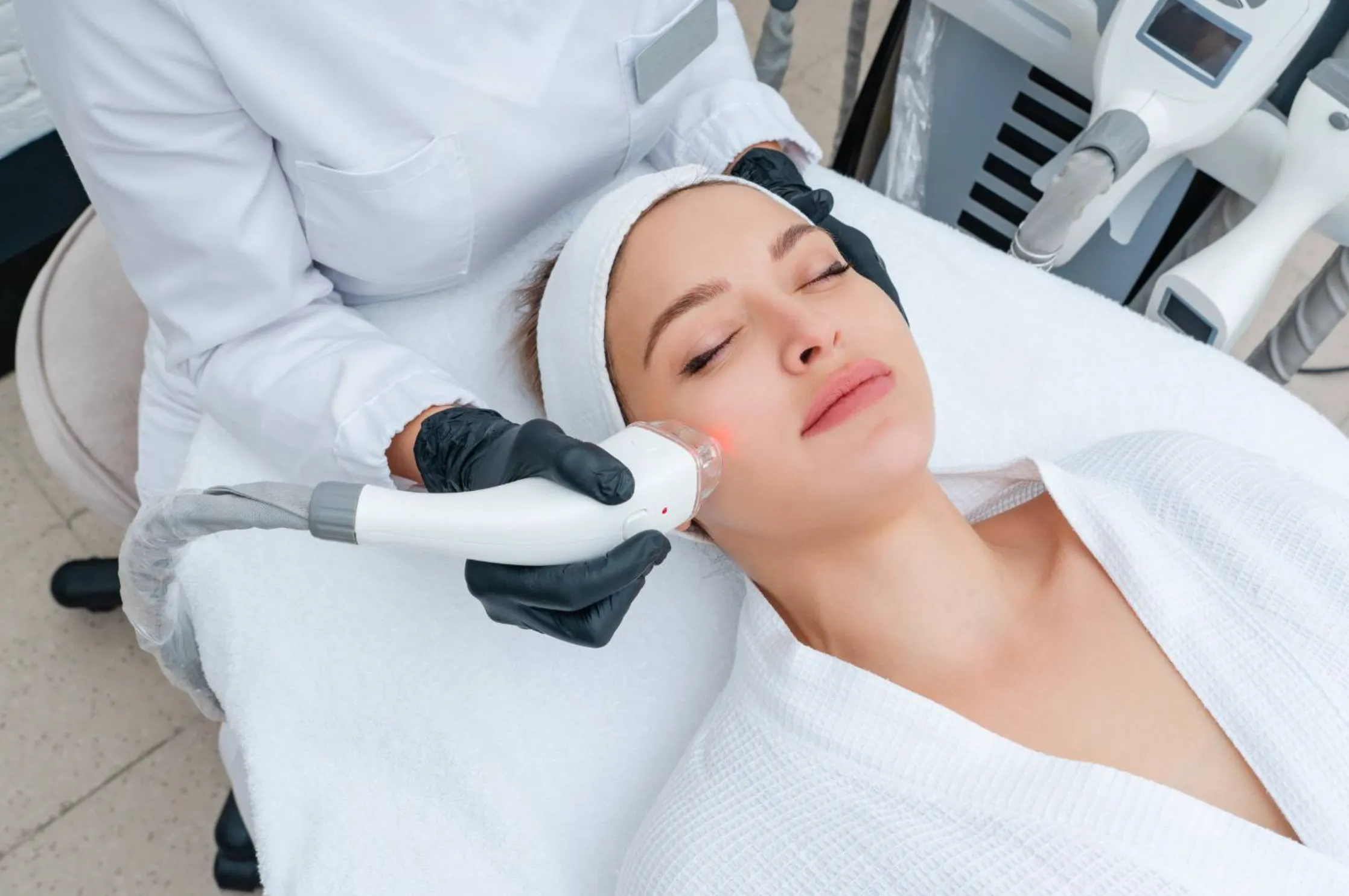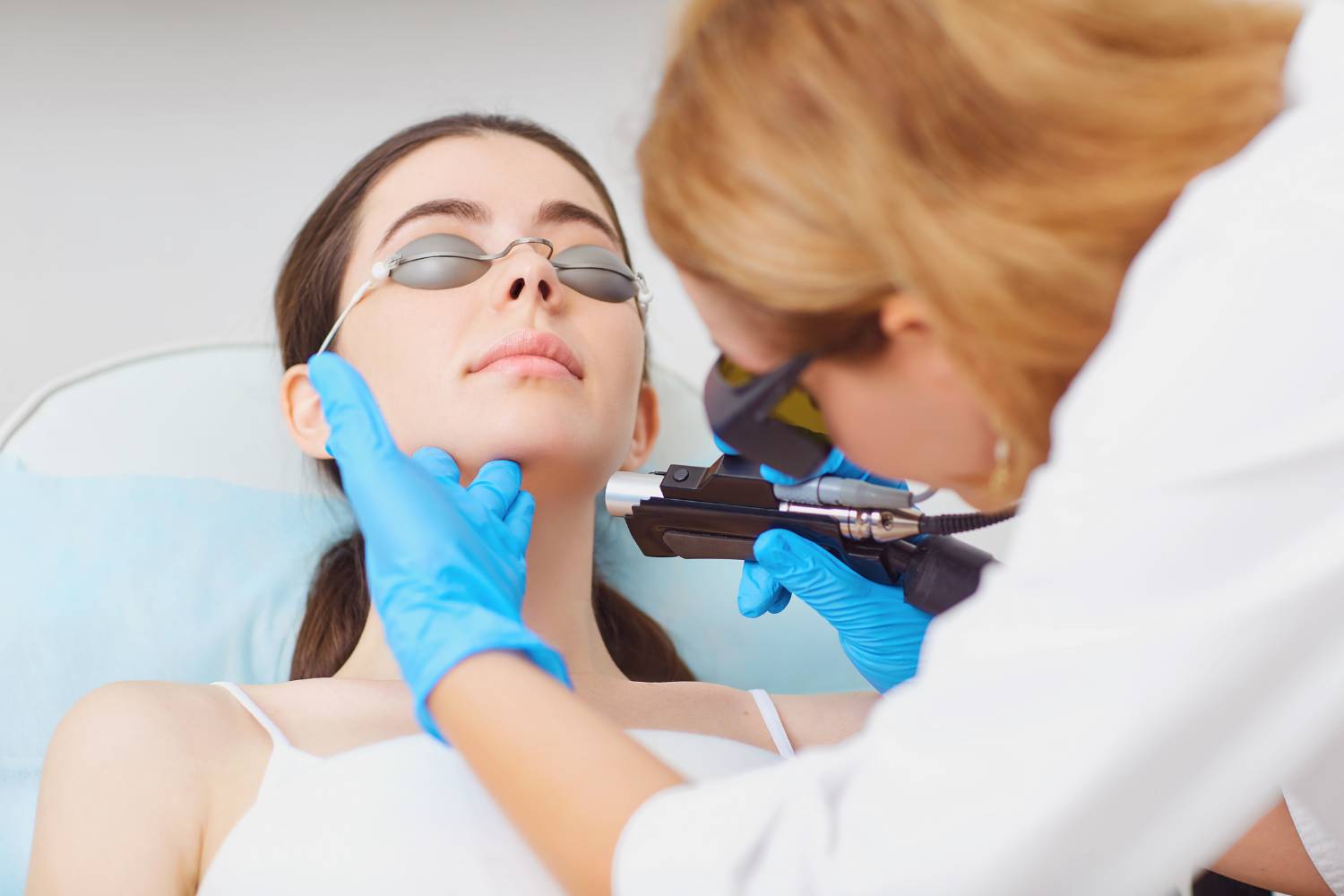
Laser Hair Removal And Hormonal Hair Growth: Key Insights For Effective Treatment
If you’ve ever struggled with unwanted hair growth or acne scars, you know how frustrating it can be to find a solution that actually works. As a practitioner, I’ve helped many clients navigate these challenges, and one thing I’ve learned is that hormonal imbalances can complicate things. Whether it’s PCOS, menopause, or thyroid issues, these conditions can affect hair growth and make laser hair removal (LHR) a bit more complex.
In this blog, I’ll explain how hormonal hair growth works, why Laser Hair Removal may require more sessions for those with hormonal imbalances, and how combining treatments can help with both hair removal and acne. Let’s dive into how to make the most of your laser treatments for smoother, clearer skin!
Hormonal Hair Growth: Understanding The Role Of Hormones
If you’ve ever dealt with excessive hair growth in areas you didn’t expect, you’re not alone. Hormonal imbalances are often the culprit. At the heart of this is a group of hormones known as androgens, which include testosterone and DHT (dihydrotestosterone). While we often associate these hormones with men, they are present in both men and women. However, when these hormones are out of balance, like in the case of conditions such as PCOS (Polycystic Ovary Syndrome), they can trigger unwanted hair growth, particularly in areas like the upper lip, chin, chest, and back.
In my own experience, I’ve had clients who’ve come into my clinic frustrated with hair growth on their face or underarms, especially after undergoing hormonal changes like starting or stopping birth control. It’s often a shock, especially when it’s a change you weren’t expecting. When someone’s hormones are in flux—whether due to PCOS, pregnancy, menopause, or thyroid issues—the hair growth cycle can be unpredictable. This is why hormonal hair growth is often thicker, darker, and, of course, harder to manage.
Common Conditions Affecting Hormonal Hair Growth
| Condition | Effect on Hair Growth | Impact on LHR | Recommendations |
| PCOS (Polycystic Ovary Syndrome) | Causes hirsutism (excessive hair growth in areas like the face, chest, and back) due to elevated androgens. | Results can be achieved, but typically require more sessions; hair regrowth may return finer and lighter, but can recur due to hormonal fluctuations. | Combine LHR with hormonal treatments (e.g., oral contraceptives, antiandrogens) for better results. |
| Hypothyroidism | Can lead to slow, uneven hair growth or thinning due to low metabolism and dormant hair follicles. | Hair may be less responsive to LHR; regrowth is slower but may be unpredictable. | Requires more sessions; effectiveness improves once thyroid function is stabilised. |
| Hyperthyroidism | It can cause faster or uneven hair regrowth due to increased metabolism and hormonal imbalance. | May need more frequent sessions as hair grows back faster. | Effectiveness increases when thyroid levels are managed properly. |
| Pregnancy | Hormonal surges may temporarily increase hair growth (especially scalp); postpartum shedding is common. | LHR is not recommended during pregnancy due to unknown effects on the mother and baby. | Wait until postpartum hormone levels stabilise before starting or resuming LHR. |
| Menopause | A drop in estrogen leads to increased facial hair, especially on the jawline and chin. | Hair may become thicker and more stubborn, but LHR remains effective with consistent treatments. | LHR works well when combined with hormone replacement therapy (HRT) or hormonal balancing. |
How Laser Hair Removal (LHR) Works For Hormonal Hair Growth?
Laser hair removal might sound like a dream solution for those dealing with hormonal hair growth, and it can be highly effective. Here’s how it works: lasers target the melanin (pigment) in hair follicles using concentrated light beams. This light is converted into heat, which damages the follicle and delays future growth. It’s most effective during the active growth phase of hair (the anagen phase), when the hair is full of melanin and thus more receptive to laser energy.
I’ve seen the process work wonders for many clients, but for those dealing with hormonal hair growth, it’s a bit more complex. Multiple sessions are needed because hair doesn’t grow all at once. For instance, clients with PCOS, like Emily, often require 8-12 sessions, as opposed to the usual 5-8 sessions required for typical cases. And let me tell you, while LHR can be life-changing, it’s not always an immediate fix. Clients may need a bit of patience, and I always make sure to set realistic expectations from the get-go.
Laser Hair Removal For Hormonal Hair Growth: What To Expect?
If you’re considering laser hair removal for hormonal hair growth, here’s what you can expect: It’s effective, but it’s going to require more than just a couple of sessions. I’ve had clients come in hopeful after their first session, only to realise that it’s a gradual process. Hormonal hair growth tends to be persistent, especially in areas where hormones are most active, like the face, chin, and upper lip.
The beauty of LHR, though, is its long-term benefits. While it may not provide an instant permanent fix, you’ll start to notice regrowth coming in lighter and finer. And for those dealing with hormonal conditions like PCOS, laser hair removal can drastically reduce hair density and provide a smoother, more manageable result.
For women going through menopause, for example, laser hair removal can help address the sudden increase in facial hair caused by declining estrogen levels. The process is gradual but effective, and I always tell my clients to think of it as a commitment, just like any skincare or health routine.

How Hormonal Imbalances Affect Laser Hair Removal Outcomes?
When it comes to laser hair removal (LHR), the results are often influenced by the balance of hormones in your body. Hormonal imbalances, particularly those associated with conditions like PCOS or thyroid disorders, can make the hair more resistant to laser treatments. In my experience, this resistance stems from the fact that hormones like testosterone and DHT stimulate hair follicles to grow more hair, and these follicles can become less responsive to the laser’s light energy.
When you’re dealing with hormonal hair growth, it’s important to manage expectations. LHR can still help, but it may not deliver the same long-lasting results that it does for those without hormonal imbalances. Some areas, especially those affected by fluctuating hormones, might require touch-ups every 6 to 12 months. Even after a series of treatments, you may notice that new growth can be softer and finer, but it’s not always permanent.
Why Hormonal Imbalances May Require More Laser Sessions?
If you’ve ever heard the saying, “Good things take time,” you’ll want to keep that in mind when opting for laser hair removal with hormonal hair growth. Women with conditions like PCOS often require more sessions than the typical 5-8 recommended for those without hormonal issues. This is because, with conditions like PCOS, hair growth can be persistent and, at times, resistant to treatments.
During the initial consultation, I make sure to explain to my clients that laser hair removal isn’t a quick fix for hormonal hair growth. Take Kelly, for example. She had struggled with excessive facial hair for years due to PCOS and was sceptical that laser hair removal would make a difference. After about 10 sessions, she saw a significant reduction in hair density and noticed that any regrowth was finer. But she also needed to come back every 6 months for maintenance.
I always remind clients that patience is key. The hormonal triggers behind the hair growth are persistent, and multiple sessions are needed to target as many follicles as possible in their anagen (growth) phase.
Post-Treatment Expectations: Maintenance And Longevity
After completing the initial series of treatments, the journey doesn’t end there, especially when dealing with hormonal hair growth. Most of my clients with hormonal imbalances will require ongoing maintenance sessions, typically every 6 to 12 months. This is because hormones can continue to stimulate hair growth in areas that have been treated, making touch-up sessions necessary to keep things under control.
Take Emma, for example. She’s in her early 40s and started experiencing increased facial hair growth after going through menopause. Initially, she thought that laser hair removal would provide a one-time fix, but after about eight sessions, she realised she’d need to return every year for a touch-up. Her results were fantastic overall, but hormones are tricky, especially with menopause, when estrogen levels drop and androgen levels can rise.
Even though Laser Hair Removal dramatically reduces hair regrowth, hormones have a way of throwing us a curveball. Whether it’s pregnancy, menopause, or even thyroid fluctuations, the hormonal landscape can shift, causing new growth. As such, be prepared for occasional maintenance, especially if you’re dealing with long-term hormonal changes.
Managing Expectations And Understanding Long-Term Care
When it comes to Laser Hair Removal (LHR), especially for those with hormonal imbalances, patience is key. I often tell my clients that LHR isn’t a “quick fix” — it’s a process. Hormonal hair growth can be stubborn, and it’s important to manage expectations along the way. For people with PCOS, hypothyroidism, or those experiencing menopausal changes, the journey to smooth, hair-free skin may take longer and require more maintenance.
The key takeaway here is that LHR works best when paired with consistent treatments and long-term care. Hormonal fluctuations can cause hair regrowth, so even after you’ve gone through your initial treatment series, regular touch-up treatments may be necessary. That said, the results are well worth it — many clients report feeling far more confident and comfortable in their skin, even if they need a few extra sessions.
Post-Treatment Care And Aftercare Guidelines
After each LHR session, proper aftercare is crucial for optimal results. I’ve seen clients who didn’t follow aftercare instructions and noticed slower progress or skin irritation, which can easily be avoided. The good news is, aftercare is fairly simple and straightforward. Here’s a rundown of what I recommend to my clients:
- Avoid Direct Sun Exposure: After treatment, your skin can be more sensitive. I tell my clients to avoid direct sunlight for at least two weeks after each session. If you must go outside, make sure to apply a high-SPF sunscreen to protect your skin from any potential damage.
- Avoid Waxing or Plucking: It’s crucial that you don’t wax or pluck between treatments. These methods remove the hair from the root, which can interfere with the laser’s ability to target the hair follicle. Shaving is perfectly fine, as it leaves the hair intact for the laser to target.
- Moisturise and Hydrate: Your skin may feel a little dry or sensitive after each session, especially if you have hormonal imbalances. Applying a gentle moisturiser can help soothe the treated area. I recommend non-scented moisturisers, as fragrances can irritate sensitive skin.
- Avoid Hot Showers and Saunas: For at least 48 hours post-treatment, avoid hot showers, saunas, or anything that causes excessive sweating. This can irritate your skin and lead to unnecessary redness or discomfort.
- Follow Your Treatment Schedule: Stick to the recommended treatment intervals. For clients with hormonal hair growth, the timing of treatments is essential to ensure you’re targeting as many hair follicles in their active growth phase (anagen) as possible. Don’t skip sessions unless advised by your practitioner.
Customising Laser Hair Removal Treatment Plans For Hormonal Hair Growth
Every client is different, and when dealing with hormonal hair growth, a one-size-fits-all approach simply doesn’t work. Customising your laser hair removal treatment plan based on factors such as skin type, hair characteristics, and hormonal imbalances is key to achieving the best results. From my experience, it’s not just about the laser itself, but about understanding the unique circumstances of the person you’re treating.
Take Beth, for instance. She had a light skin tone but darker, coarser hair due to hormonal changes following menopause. We knew that she’d need a laser type suited to her skin tone and hair type to ensure optimal results. After assessing her condition, I opted for a diode laser, which is effective for targeting darker, coarser hair while still being safe for lighter skin tones. In her case, the treatment was more effective than some other lasers might have been, and we customised her sessions accordingly.
When it comes to people with darker skin tones (types IV-VI on the Fitzpatrick scale), selecting the right laser is even more critical. These individuals often benefit from Nd:YAG lasers, which penetrate deeper into the skin without causing damage to the superficial layers. This makes Nd:YAG lasers ideal for people with darker skin tones who are also dealing with hormonal hair growth. The key takeaway is that the treatment plan needs to be tailored to the individual, as different hormonal conditions and skin types respond differently to lasers.

Expecting More Sessions And Maintenance: What To Prepare For?
It’s important to set realistic expectations for those with hormonal hair growth, as you may need more sessions than a typical laser hair removal treatment plan requires. Hormonal imbalances mean that hair follicles may be more resistant to laser energy, and hair growth can persist longer. I always remind my clients that laser hair removal for hormonal hair growth is a commitment, not a one-time fix.
For example, Karen, a client in her late 30s dealing with facial hair due to menopause, initially thought she’d be done after the standard 6-8 sessions. But after her first series of treatments, we saw that more sessions would be necessary. With her hormonal fluctuations, we had to adjust her treatment schedule to accommodate her changing needs. After 10 sessions and a few follow-up touch-ups, her results were fantastic: the regrowth was minimal, and her facial hair was much lighter and finer.
Even after a successful initial round of treatments, hormonal hair growth can always make a comeback due to ongoing hormonal fluctuations. This means that, for many clients, maintenance sessions every 6-12 months are often necessary to keep things under control. The silver lining is that with consistent treatment, the hair will continue to grow back lighter and less dense, which helps reduce the overall impact of the hormonal imbalance over time.
Laser hair removal (LHR) is an effective solution for managing unwanted hair, especially for those battling hormonal imbalances like PCOS, menopause, or thyroid conditions. However, the key to successful treatment lies in understanding how hormones affect hair growth and adjusting expectations accordingly. While laser hair removal can drastically reduce hair density and provide smoother, more manageable skin, hormonal conditions often require additional sessions and ongoing maintenance. The journey is gradual, but with the right treatment plan, patience, and perhaps a little hormonal management, you can achieve lasting results.
If you’re dealing with hormonal hair growth, I highly recommend working with a professional who can tailor the treatment to your unique needs. Combining laser hair removal with the right medical management can boost results and help keep unwanted hair at bay. Whether you’re looking to manage PCOS-related facial hair or reduce the impact of menopause, laser hair removal can be a game-changer—just remember that consistency and realistic expectations are key!

